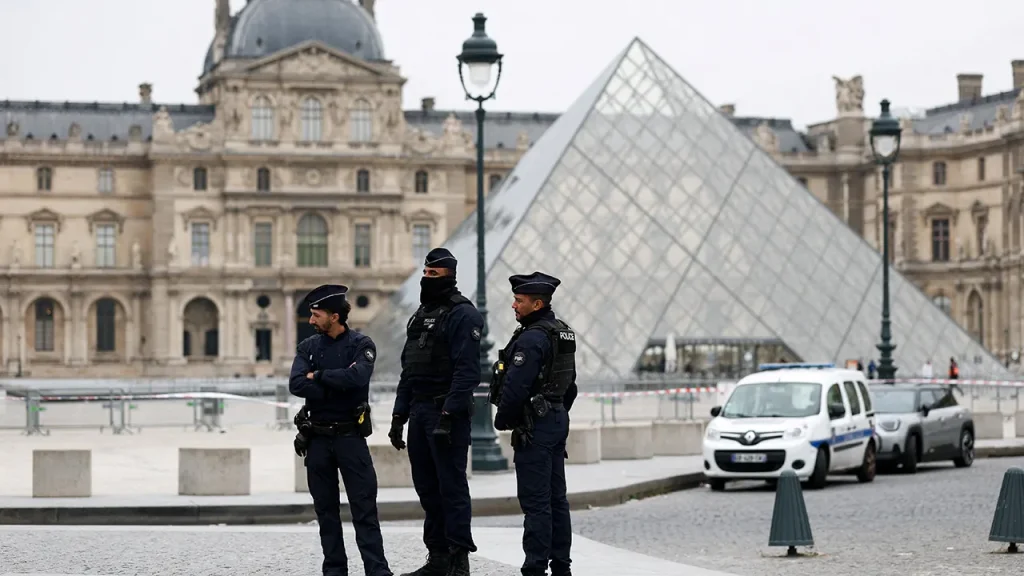Historic Heist at the Louvre: Seven Minutes That Shook Paris’s Famed Museum
In a daring raid that has shocked the art world and French authorities alike, thieves broke into the Louvre Museum in Paris, stealing priceless jewelry in a meticulously planned seven-minute operation. French Interior Minister Laurent Nuñez described the incident as a “major robbery,” highlighting both the audacity and precision of the criminals who made their escape on motorbikes through the streets of Paris. The thieves employed sophisticated tactics, accessing the museum from an exterior point using a basket lift and cutting equipment to slice through protective glass enclosures housing precious artifacts. This breach of one of the world’s most famous cultural institutions has raised serious questions about security protocols at the landmark that houses over 33,000 priceless works spanning millennia of human creativity.
The target of the heist appears to have been the Apollo Gallery, which contains part of the French Crown Jewels—artifacts of immense national significance. According to reports from French newspaper Le Parisien, the thieves strategically entered through a section of the museum that was under construction along the Seine River, utilizing a freight elevator to access their target location. The criminals’ selective approach resulted in the theft of nine pieces from Napoleon’s jewelry collection and items belonging to Empress Eugénie. In a curious development that speaks to either haste or tactical calculation, a crown believed to have belonged to the Empress was later discovered broken outside the museum grounds, perhaps abandoned during the thieves’ rapid escape or intentionally left behind for reasons yet unclear.
Beyond the immediate financial value of the stolen items, French authorities have emphasized the “inestimable heritage and historical value” of the artifacts taken. These pieces represent not merely luxury items but tangible connections to France’s imperial past and cultural legacy. The theft has prompted an immediate investigation as officials work to compile a detailed inventory of the stolen items, many of which are irreplaceable historical artifacts whose significance transcends monetary assessment. The Louvre, which houses iconic masterpieces including the Mona Lisa, the Venus de Milo, and the Winged Victory of Samothrace, temporarily closed its doors following the incident, citing “exceptional reasons” without elaborating further—a rare occurrence for an institution that welcomes millions of visitors annually.
This heist at the Louvre comes at a time of increasing concern regarding the security of cultural treasures worldwide. The incident follows other high-profile cases of art and artifact theft, including recent incidents involving Egyptian antiquities. Such crimes highlight the persistent threat to cultural heritage sites and museums, which must balance public accessibility with the protection of irreplaceable collections. The sophisticated nature of this particular robbery—utilizing construction areas as access points and targeting specific high-value items—demonstrates the evolving challenges facing cultural institutions in safeguarding their collections against determined criminals with knowledge of museum layouts and security systems.
The theft has sparked widespread speculation about the ultimate destination of these historical treasures. Unlike more famous paintings that would be instantly recognizable and therefore difficult to sell, jewelry—even pieces with historical provenance—might be broken down for precious materials or disappear into private collections through illicit channels. The investigation now facing French authorities will likely extend beyond national borders, involving international law enforcement agencies and specialized art crime units. The recovery of stolen art and artifacts often involves years of painstaking investigation, with some pieces remaining missing for decades while others are eventually recovered through targeted operations or unexpected discoveries.
For the Louvre and similar institutions worldwide, this brazen theft will inevitably prompt a comprehensive review of security measures and emergency protocols. Museums face the perpetual challenge of protecting priceless artifacts while maintaining their accessibility to the public—a fundamental aspect of their cultural mission. As the investigation continues, the focus will remain not only on recovering these irreplaceable pieces of French history but also on understanding how such a sophisticated breach occurred at one of the world’s most visited and presumably secure museums. The seven-minute heist at the Louvre serves as a stark reminder of the vulnerable nature of our shared cultural heritage and the determined efforts required to protect it for future generations.


